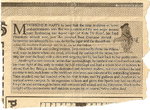You're right, it is interesting. One of the things I was amazed to see was how the covariance matrix between shares shifted when the credit crunch hit. All of a sudden the correlations virtually doubled. I was so lucky to have a time period like that to look at; it added so much to the results. Cheers for the link, I have been an admirer of Fama's work for a while now. It was people like him that made me want to become an academic. (Back when I wanted to go down that path)
If this interests you, look up something called CrashMetrics (nothing to do with JPM). It is used to better approximate the VAR of a portfolio in "fire sale" conditions like we saw during the crunch; where all assets fall, and so become perfectly correlated (well, nearly, but you get the idea).
Most of the rugby team cant talk to a girl until the 8th pint of snakebite black has gone down (and sometimes back up). But there is a window between the eigth and the tenth when they're unstoppable. I however am different, I can sometimes talk to them after only 6 😀 Still get through more skirts than the footballers though, now they really are all talk and no trousers.
Perhaps, but did you ever swatch us in action on the lash?

